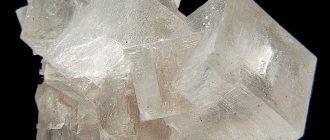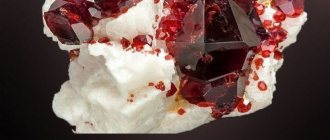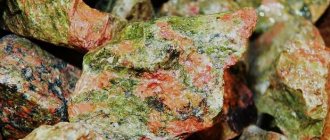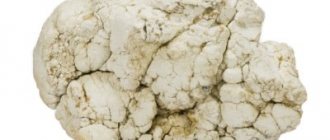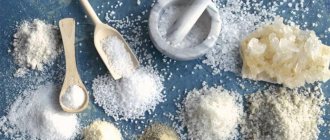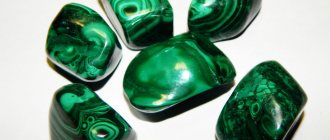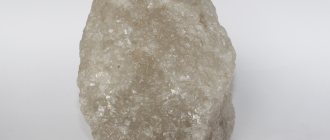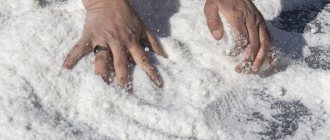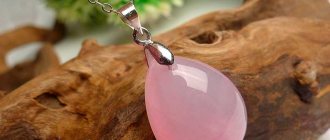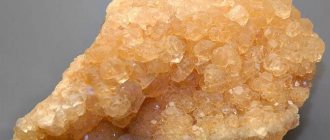| Category | Halides (minerals) |
| Title in English | Halite |
| Formula | NaCl |
| Group | Chloride group |
| Color | White, Colorless, Blue, Red, Violet, Yellow |
| Stroke color | White |
| Shine | Glass, Bold |
| Transparency | Translucent, Translucent |
| singonia | Cubic |
| Hardness | 2 |
| Cleavage | Perfect to the cube |
| Density, g/cm³ | 2,1 — 2,2 |
| Kink | Conchoidal |
| origin of name | Since halite in its essence is rock salt and is even used in the food industry, the Greek word “halos” was used for the name, translated into Russian as “salt”. Moreover, “lithos” means stone. |
| Morphology | Halite has cubic crystals and only occasionally octahedral ones. In addition, rock salt creates skeletal crystals. Halite creates fine-grained to giant-grained aggregates, as well as druses, efflorescences, crusts and plaques. |
Halite is a natural mineral of halogen origin, and belongs to the sodium chloride group. Its history is comparable in duration to the development of life processes on our Earth, because salt is one of the main components of sea water. The term “halite” itself is translated from ancient Greek as “sea salt”. The mineral is usually painted white, but there are examples of blue and red colors, as well as colorless ones.
Magic properties
The simple composition of rock salt does not seem to have any magic. However, the existence of folk beliefs about salt, based on life experience, proves that halite has some magical powers. For example, if you pour a cross out of salt, you can provide protection from evil spirits, and if you accidentally scatter it, then in the near future you can expect quarrels or illnesses in the house.
Slavic warriors believed that a handful of earth mixed with salt would protect them from death on the battlefield. Since ancient times, people believed that the mineral was capable of:
- protect from evil spirits;
- warn against dangers and troubles;
- protect from the evil eye of ill-wishers;
- bring good luck;
- attract good people around.
Since ancient times, children and adults have had a piece of halite sewn into their clothes. Such a talisman helped protect a person from the negative influence of strangers.
Astrologers believe that salt amulets can be worn by all people, regardless of their zodiac sign. In order for crystals to exhibit magical powers, they must be hidden from prying eyes and worn only under clothing.
Magicians use salt in their rituals, as it is capable of returning evil to the one who wished it, and the positive message can be strengthened several times with the help of halite. For this reason, spells made on such amulets to attract good luck, love and happiness are highly likely to be effective.
Physical properties
Optical
Color. Colorless and often white, gray to black, red, brown, yellow, blue (sky blue to dark indigo), violet, mauve to dark purple; occasionally green. The gray color is often caused by clay inclusions; black and brown, disappearing when heated, due to an admixture of organic substances. Brown and yellow tones are sometimes associated with an admixture of iron compounds, in particular tiny needles of hematite; in the latter case, the color is usually distributed unevenly or streakily. The green color may be caused by inclusions of Douglasite; in this case, the halite on the surface turns brown when exposed to air. Blue, violet and yellow colors that disappear in light are caused by exposure to radioactive radiation. The source of β-radiation in salt deposits is K4o and the accompanying radioactive Rb, which is confirmed by the repeatedly noted fact that halite turns blue in the vicinity of sylvite and other potassium salts, as well as laboratory studies.
The nature and intensity of staining is determined by the amount of β-radiation received by the sample and its sensitivity to radiation. The latter depends on many reasons, the most important of which are the following:
Halite with sylvite granular aggregates. Ural Solikamsk
1) the degree of deformation of the lattice and the presence of certain stresses in it;
2) the amount and nature of impurity elements in the irradiated material, for example, an increased content of Ca was noted in blue salt, and Cu in violet salt; the total amount of impurities in purple and blue salt exceeds the amount in yellow salt; Neutral Na atoms were found in blue salt from Solikamsk
3) growth rate of the colored crystals. Very often, the blue color is distributed unevenly in crystals due to the locality of irradiation or the sensitivity of the crystals to it: in the form of zones parallel to the faces of the cube, irregular areas isolated from each other, edges, spots, winding stripes, etc. The colored areas themselves differ from each other from each other by a structure discernible under a magnifying glass: reticular, dotted-reticulate, dashed, spotted, zonal, spiral, etc. Sometimes this phenomenon is caused by the fouling of colored skeletal crystals with colorless salt.
The color caused by radioactive radiation disappears when heated in light, but the samples retain increased colorability.
- Line white to colorless
- Glass shine.
- The cast on a stale surface is greasy to greasy.
- Transparency. Transparent or translucent.
Mechanical
- Hardness 2, slightly different when scratching along the edge and along the diagonal of the cube. The average hardness on a cube face is less than on an octahedron face. The hardness of dark blue salt is significantly higher. Microhardness 18-22 kg/mm2. It is easiest to polish along the edges of the cube, hardest along (110) and worst of all along (111). The impact figure looks like a four-ray star made of cracks in the plane of the rhombic dodecahedron.
- Density 2.173, often fluctuates due to the presence of inclusions, for example, salt from Kalush from 1.9732 to 2.2100; There was an increase in density with increasing intensity of blue color
- Cleavage according to (100) is perfect, according to (110) imperfect (the fine structure of the cleavage planes was studied under an electron microscope)
- The fracture is conchoidal.
It is quite fragile, but when heated, its ductility increases significantly (in a hot saturated solution it can be easily bent by hand); it also becomes plastic under prolonged one-sided pressure (the degree of plastic deformation of halite can be judged by the optical density values in the region of 380-600 tpc, which depends on the degree of light scattering in the deformed areas).
How to care
The mineral is fragile, dissolves in water, and has low hardness. Given these properties of halite, you need to care for it carefully:
- For collection material, select a personal, durable, ventilated box.
- Protect from moisture. The humidity in the room should also be lower.
- A glass, wooden, ceramic container or linen bag is suitable for storing kitchen salt. It is advisable to cover the salt shaker on the table.
To maintain condition, crystals or halite products are rinsed with a saturated saline solution or wiped with alcohol or gasoline. Then it is dried and polished with velvet cloth.
Storage and care
Both commercial and table salt should be stored in ventilated places with low humidity. The container containing the substance must always be kept closed. When using halite for food purposes, take the substance with a clean, dry spoon. For storage you can use linen bags, glass jars, wooden or ceramic salt shakers.
Technical halite is kept in closed warehouses or on open asphalt/concrete areas under a canopy with necessarily created drains to remove precipitation.
Halite
Halite (from the Greek ἅλς - salt) is a mineral from the class of halides, subclass of chlorides: sodium chloride. Synonyms: rock salt, table salt. Chemical formula: NaCl.
Physical properties and photos of halite
Glass shine. Hardness 2. Specific gravity 2.1-2.2 g/cm3. Colorless, white, greyish, pink, red, brown, blue, indigo. It is not uncommon to observe different colors within the same sample. The line is white.
Crystalline halite exhibits perfect cleavage in three directions along the faces of the cube. Solid granular, dense, leafy, fibrous, sintered (stalactites and other forms); also drusen, crystals and plaque. Cubic system.
The crystals are grown and ingrown and are usually cubic in shape.
The crystal lattice of halite is ionic. The lattice nodes, which have a cubic shape, contain positive sodium ions and negative chlorine ions. This is due to the presence of perfect cleavage in crystalline halite in three directions along the faces of the cube.
Features. Halite is characterized by a non-metallic luster, medium hardness, salty taste, and perfect cleavage in three directions along the cube faces, observed in crystalline varieties. Rock salt is similar to sylvite. It differs in taste (Sylvin’s is bitter) and color (Sylvin’s is milky white).
Chemical properties. The taste is salty. Easily dissolves in water.
Halite. Photo. G. Zell Galit. Photo by Pyotr Sosonovsky Cubic crystal of rock salt. Hans-Joachim Engelhardt Stone salt with green illumination in the Museum of Mineralogy Bonn
Origin of halite
The surface is mostly lagoonal and lacustrine chemical sediment. There are ancient and modern deposits.
The ancient ones are represented by rock salt and are chemical sediments of ancient sea bays, lagoons and lakes, formed under conditions of intense evaporation (hot, dry climate). Rock salt occurs in the form of layers, stocks or domes among sedimentary rocks.
Layered deposits usually occupy large areas (tens and hundreds of kilometers) and have great thickness (up to 100 m or more).
Modern halite deposits are represented by salt lakes, bays, lagoons, where the process of sedimentation and accumulation of salt continues to occur today. In addition, relatively small concentrations of salt are observed on the walls of volcanic craters, at the outlets of salt springs, in desert and steppe areas - on the soil surface (“efflorescences”).
Satellites. Silvin, carnallite, gypsum, anhydrite.
Applications of halite
Halite is a raw material for the production of hydrochloric acid and its salts (caustic and soda ash, chlorine gas, ammonia, etc.). Almost no industry can operate without salt. Salt is used in the manufacture of more than one and a half thousand different products.
Salt is used in refrigeration, as a food product, for canning meat, salting fish; for salting soap and organic paints, for salting leather; in metallurgy – for chlorinating roasting; in ceramics - for glazing clay products, in medicine.
Salt is used in the production of aluminum and bleach.
Halite also serves as an ore for the production of metallic sodium and chlorine, as well as all compounds of these elements.
Metallic sodium is used to produce alloys, as a reducing agent in metallurgy, as catalysts in the production of organic compounds and in the electrical industry - for the manufacture of wires (sodium “cores” covered with a copper sheath) and discharge lamps.
Sodium lamps are used for street lighting. They are twice as bright and almost three times as durable as mercury ones. Sodium lamps also increase the contrast of objects.
It has been established that 1 mm3 of rock salt can store up to a billion pieces of information. This opens up the possibility of using grains of salt in computers. Sodium-sulfur battery is a lead-oxygen battery of equal weight. Sodium coolant is used in nuclear reactors.
Concentrated solutions are good antiseptics.
Place of Birth
The world's largest lake in terms of reserves of table salt is Lake. Baskunchak; The lake is also famous. Elton (both are located in the Volgograd region).
The Sol-Iletsk rock salt deposit (Orenburg region), Usolye - near Irkutsk, in Yakutia, as well as the Slavyano-Artemovskoe and Prikarpatskoe deposits (Ukraine) have long been known. Formative deposits with a large distribution area include the Statfurt salt basin in Germany, the salt deposits of the states of Kansas and Oklahoma in the USA, and the Saskatchewan basin in Canada.
Applications of halite
Due to the properties of rock salt, its use is not limited to food consumption. A person cannot do without table salt. Halite is in demand in technological processes in various industries. It is widely used not only in the food industry for preserving meat, fish and vegetables, as it is a cheap preservative.
In the chemical industry, the compound is necessary for the production of hydrochloric acid, which is in demand in various sectors of the economy.
In metallurgy, the mineral is used as a coolant for hardening, as well as for the production of a number of compounds of non-ferrous metals. It is part of the electrolyte.
The pharmaceutical industry uses halite for the manufacture of drugs and injection solutions.
The healing properties of the mineral
Salt has a unique anti-inflammatory and antiseptic effect and is indispensable during the treatment of colds and viral ailments.
Halite is a mineral that is used in the preparation of a solution to treat the throat. It contains: water, iodine and salt. It is also used to dull toothache by preparing a solution of warm water and one tablespoon of salt. A bag of hot mineral is excellent for radiculitis, bronchitis, boils and boils. Heated salt is also used to treat a prolonged runny nose.
Classification
The mineral is divided into primary and secondary. The deposit of the first is ancient salt pools. It is characterized by inclusions of other rocks. The second appeared later due to the redeposition of primary halite. The composition contains a large amount of bromine.
Secondary halite is transparent and coarse-grained in structure. When deposited in layers, its structure is more dense and its color is white. Blue coloring of the peripheral edges is a sign of radioactivity.
Based on the chemical characteristics and place of formation, the mineral is divided into the following types:
- Rock salt. The rock is formed after the compaction of sedimentary halite, formed in ancient geological eras.
- Self-salting salt. Visually it resembles plaque with a fine-grained structure.
- Volcanic halite. The formation of rock occurs during vulcanization; it is found in craters.
- Salt marshes. They occur superficially in steppes and deserts, resembling deposits on the soil.
Physical properties
Color: depends on the inclusion of metals and can vary from colorless to red.
- Luster: low, glassy.
- Hardness on the Mohs scale: 2.
- Fracture: conchoidal.
- Specific gravity: 2.1 – 2.2 g/cm³
- Syngony: cubic.
- Taste: salty, not bitter.
- Fragility: high.
- Conductivity of electricity: none.
- Melting point: 800°C
- Hygroscopic and completely soluble in water.
Halite mining
The main mineral deposits are located in the basins of dried up ancient salt water bodies. Deposits form in domes or layers close to the earth's surface. The latter are characterized by a layered structure and interspersed with clay and sandstone. Dome-shaped deposits are formed in the process of movement of overlying rocks and their pushing of lower, softer layers of halite into weakened zones. Their size can be measured in tens of kilometers.
New halite deposits are constantly being formed. Elite varieties of table salt are extracted from currently active lakes, and the layers of halite are located below.
Locations of the largest deposits today:
- Russian lakes Baskunchak, Elton;
- Slavyano-Artemovskoe and Prikarpatskoe fields in Ukraine;
- In Germany, Austria;
- Kansas, Oklahoma in the USA;
- Saskatchewan Basin in Canada.
Chemical composition of halite
| Variety | Sodium chloride (% not less) | Calcium ion (% no more) | Magnesium ion (% no more) | Sulfate ion (% no more) | Potassium ion (% no more) | Iron oxide (% no more) | Insoluble residue (% no more) | Moisture content (% no more) |
| Higher | 98,1 | 0,35 | 0,05 | 1 | 0,1 | 0,005 | 0,25 | 0,25 |
| First | 96,5 | 0,35 | 0,05 | 1,2 | 0,1 | 0,005 | 0,75 | 0,35 |
| Second | 93 | 1,8 | 0,08 | 0,9 | 2,2 | 0,1 | 2,5 | 3,5 |
To protect against the formation of lumps and subsequent clogging of equipment, the range includes salt with an anti-caking agent, which improves flowability.
Where is it used?
Halite has found use among industrialists, medical workers and housewives.
Household sphere
Salt is a universal assistant in solving household problems:
Unsalted food is tasteless and unhealthful
Sometimes it is enriched with iodine, which is important for maintaining health. It is added when washing colored clothes or bed linen to prevent fading. Salt (or soda can be used) to remove old dirt on dishes, porcelain, and neutralize the musty smell in the microwave or refrigerator. Easily dissolves fresh wine and ink stains. For women it is important as a natural effective skin scrub.
Another hundred million tons of halite are taken by industry.
Industry
Halite is widely used in various industries:
- Cleaning boilers and heating systems from scale at enterprises. At the same time, aquatic microorganisms are neutralized.
- When extracting oil in permafrost zones, they dissolve ice and soften the soil. To facilitate the extraction process, wells are filled with salt water.
- A component that increases the strength of sand-lime bricks.
- The source for the synthesis of caustic soda and chlorine, from which paper, plastic, glass, soap, and aluminum are then obtained.
- Cheap, environmentally friendly coating for icy roads.
Jewelers are not interested in the mineral. Collectors are delighted with unusual specimens of halite of various origins.
Story
The origin of the mineral is inextricably linked with the formation of the salty ancestral ocean, which was the source of all life on earth.
In ancient times, salt was worth its weight in gold: it was exchanged for precious metals, slaves were bought for it in Ancient Rome, and the service of ancient soldiers and officials was partially paid for.
One of the most ancient trades - the extraction and trade of salt - originates in Russia approximately from the 11th - 12th centuries. After Prince Svyatoslav established a tax on salt production (1137), princes, boyars and large cathedrals often began to own varnitsa.
From time to time, salt became the cause of popular unrest.
The salt riots of 1648 broke out in a number of Russian cities after the introduction of a single tax on salt.
At the beginning of the 18th century, Peter I declared a salt monopoly: all rights to produce the product now belonged entirely to the state. This lasted until 1862, when Alexander II adopted a decree on the gradual transfer of salt production to private entrepreneurs. He also introduced excise taxes, which lasted until 1880.
By the end of the 19th century, there was a shortage of salt in Russia. They compensated for it with imports from European and Asian countries.
Nowadays, the value of halite is high as a raw material for the synthesis of caustic soda and chlorine, which serve as the basis for the production of a number of substances:
- aluminum;
- plastics;
- paper;
- glass;
- soap
Russia ranks 19th in the world in salt production.
The magical properties of halite
Widespread and simple in composition, halite, at first glance, does not have a supernatural purpose, but the magical potential, prayed for by people for many centuries, helps to increase good and fight evil.
There are many signs and sayings associated with salt, which were formed by the people of different countries based on observations. It was believed that a handful of halite, sprinkled on the ground in the form of a cross, protects against evil spirits. On the other hand, spilled salt was perceived by many people as a signal of impending trouble and disease. The Slavs, when going on a campaign or to war, always took with them a handful of earth mixed with salt to protect themselves from mortal wounds.
To this day, magicians and sorcerers use halite in occult rituals. Halite increases good intentions many times over, but the mineral will return evil and envy like a boomerang in multiplied quantities. Spells with halite for good luck, love and happiness are effective, but for them to work you need to carry talismans with you. A pinch of crushed salt is sewn into children's clothes to protect them from damage and the evil eye. A mineral amulet protects its owner from emergencies, natural disasters and violent acts.
Halite, as a talisman, does not like extraneous energy and, when exposed to public display, can absorb someone else's negativity. To prevent this from happening, it is necessary to keep secret the composition of the talisman or amulet and hide it from prying eyes.
Where is halite mined?
More than 7 million tons of salt are mined annually for human consumption; even more is needed for its use in industry, so the extraction of the useful mineral has been put on stream.
There are several ways to obtain rock salt crystals:
- Most of it is mined in mines, from which layers of the mineral are extracted and subsequently processed - cleaned and crushed.
- Another method is digestion - first they drill a well, pump clean water into it, which is pumped back after this mineral has dissolved. This method produces a pure product free of impurities.
- The most ancient way to obtain the mineral is by evaporating crystalline grains of salt from sea water. Currently, it is practically not used, since the process takes too much time.
Halite crystals form in areas with a dry, hot climate. Rock salt deposits were formed in North America and Europe many millions of years ago. The leaders in salt reserves are the USA, Canada and Germany. In America, the saltiest states are Texas, California, and Kansas.
Mining of rock salt in Russia occurs in many places. The largest accumulation of mineral deposits is located in the Urals - these are the Solikamskoye and Sol-Iletskoye deposits, in the lower part of the Volga, in the Perm and Orenburg regions, in Yakutia. The largest mining site for this mineral in our country is Lake Baskunchak. There are also deposits of the mineral halite in Crimea and Donbass.
Halite deposits
Halite deposits are widespread on the planet, and even at very great depths. Well-known mines are located in the Donbass, Perm, Lower Volga region, and Transcarpathia. Deposits with beautiful valuable crystals are found in Poland. Large reserves of halite have been discovered in Germany and Austria.
Other uses of halite
In world practice, there are more than 14 thousand uses of salt. Which speaks about the extraordinary and beneficial properties of this mineral. Salt solutions are needed for processing clothing, leather and fur products, and in the production of glazes for porcelain and earthenware. Since salt is a strong natural antiseptic and preservative, it is actively used in the food and medical industries, being simply irreplaceable there. For example, it is used to produce medicines based on isotonic solutions, which have no alternative for human treatment. Also, in food production, halite is used as “artificial cold”, providing the required temperature for storing and freezing food products and their components. Due to its low cost, halite continues to be the most economical material for the production of salt-ice cooling mixtures.
We should not forget about the active use of mineral salt in construction. It has found its application in the manufacture of magnesium screeds and floors, in addition, it is absolutely necessary for the manufacture of products from decorative magnesite concrete. In addition, salt is used:
- For the production of sand-lime bricks. It is used as an active additive to increase the resistance of bricks to sudden temperature changes, which is very important in difficult climates. In addition, sand-lime brick becomes more durable, strong and reliable, and has a lower cost compared to a product for the production of which technical salt was not used.
- To accelerate hydration, setting and shrinkage of cement. Adding salt increases the reliability and service life of objects; in addition, it significantly reduces the overall construction period - by about half.
- Technical salt is actively used in the production of such common products as washing powder, paper, glass, and soda.
Salt is a necessary and useful material, the scope of its application is constantly expanding due to its wide availability, complete safety and low cost.
Product Quality Check
Checking the quality of industrial salt (as well as feed and table salt) is strictly regulated. Every serious salt producer develops technical specifications (TS) for salt and subsequently carefully monitors compliance with product quality requirements.
In general, mineral salt must meet the following parameters: odorless, but have a pronounced salty taste. The color may be white or grayish (sometimes with a yellow tint). The color of halite depends on the deposit where it is mined. But the amount of foreign impurities in industrial salt is strictly regulated. The product is a free-flowing crystalline substance. Sediment in water is allowed within certain limits.
The largest reserves of salt in the world are in Lake Baskunchak
When purchasing halite, you should keep in mind that products for municipal services are subject to seasonal price increases. Demand for halite as a road reagent increases sharply from November to February. Thus, the most profitable solution in economic terms would be to purchase halite before the onset of frost.
Applications
The mineral is used as amulets, talismans, and also for treatment. Salt procedures, such as massage, are done to maintain a healthy appearance and beauty of the skin. Such manipulations are often carried out in baths and saunas, when the body is steamed and beneficial substances penetrate the skin layers more easily.
It is known that the mineral is an important component of metabolic processes. To ensure normal functioning, all people need regular use of this substance. Of course, excessive consumption of salty foods will lead to problems, but you should not exclude the product from your diet, you need to stick to the “golden mean”. For an adult, the average norm is 15 g of salt. This quantity includes the volume of the substance contained in the finished products.
In industry, the use of halite makes it possible to obtain chlorine and sodium. These are substances that are used to make baking soda and alkaline preparations, such as household cleaners.
High-quality halite crystals are used to make items that decorate interiors, but samples suitable for such work are rare. There are also jewelry with inserts of salt crystals. Such items should be stored away from exposure to heat and sun, and in a dry place. It is necessary to avoid moisture, as rock salt melts in water.
In order to experience the benefits of halite, you need to choose natural products and products made from natural materials. Checking the authenticity is not difficult. Simply dip the crystals into water. A naturally occurring substance will keep the liquid clean (there may be a slight sediment). Otherwise, the water will change color. This is an indication that the stone has been treated with artificial dyes.
A useful mineral indispensable in modern life
The importance of white crystals has been proven, but you should not overuse them. You always need to maintain a balance, and the beneficial effects of rock salt on the body will change the life and health of every person
Areas of application
The mineral is an important raw material for the food and chemical industries. During the year, the entire population of the globe consumes approximately 7,000,000 tons of salt. It is impossible to imagine cooking without this substance.
The main use of technical halite is as a reagent for combating ice: it contributes to the formation of a slurry that destroys ice on asphalt. To enhance the effect of halite, stone chips or sand are added to it. The use of such mixtures allows you to effectively and quickly deal with icing on the roads.
The main advantages of technical salt - halite:
- easy to use;
- resistant to sub-zero temperatures (down to -30°C);
- does not harm the environment;
- economical;
- low cost.
A similar reagent is used with high efficiency in oil production: it dissolves ice and softens the soil. At low temperature conditions, the brine solution is pumped into finished wells and facilitates the process of oil production.
The tablet form of the mineral is used for cleaning industrial boilers and heating systems. The product effectively removes scale and purifies water from harmful bacteria.
In construction, halite is an important element in the sand-lime brick production process. It makes the building material resistant to sudden temperature changes and, accordingly, makes the building more reliable.
Zodiac sign
Halite has a strong and ancient connection to the earth, like every person. Therefore, this substance is shown as a talisman to representatives of any zodiac sign.
Medicinal properties
Halite has many healing properties:
- A water-salt solution with added iodine is effective for rinsing a sore throat;
- For radiculitis pain, bags of hot salt applied to problem areas provide effective assistance;
- Gargling with warm salt water helps with toothache;
- Hot salt wrapped in a cloth deeply warms the chest when coughing.
The beneficial effects of salt caves on the body are known. Specially equipped rooms - halochambers, the walls, floor and ceiling of which are covered with salt, and the air is saturated with ions of useful minerals, are available in all major cities. According to medical research, treatment in halochambers accelerates recovery from a number of diseases, strengthens the immune system, and removes toxins.
Five sessions of approximately 40 minutes each can be compared in terms of benefits to two weeks at the seaside.
Such procedures are especially useful for children. Salty air filled with ions cleanses the respiratory tract and removes allergens and viruses from the body. This therapy does not require the use of additional medications, which is especially important for a child.
Staying in a halochamber calms the nervous system, helps reduce anxiety, depression, and improves sleep. But this procedure, like any other, has a number of contraindications:
- Allergy, individual salt intolerance;
- Temperature increase;
- Oncology;
- Acute form of chronic diseases;
- Epilepsy;
- Tuberculosis;
- Claustrophobia;
- Severe mental disorders;
- Drug addict;
- Cardiac ischemia;
- Hypertension;
- Bleeding;
- Kidney diseases;
- Purulent processes;
- Coronary insufficiency.
Before the procedure, it is better to consult your doctor. After approval of treatment, you need to prepare for a trip to the salt cave: eat an hour before visiting; Do not drink or eat for half an hour after the procedure. During the session, you should not sleep or rub your eyes so as not to burn the mucous membrane.
Magic properties
The magical properties of rock salt and its role as a talisman are mentioned in many folk tales and legends. It is not for nothing that Vasilisa the Wise deceives Koshchei and sets him off on the wrong trail with a handful of salt, and Baba Yaga presents it to Ivan the Soldier so that she will protect him in the world of the dead, where he was heading in search of his beloved. European fairy tales often have the following motif: a girl throws salt on the table at which the groom, who has forgotten her, is sitting. Salt magically drives away evil spells from him, he regains his sight and recognizes his bride.
This mineral has long been considered a talisman by the military. It is known that during the Second World War, front-line soldiers kept bags with a handful of their native soil and salt.
There are many strong salt spells for a love spell, protecting a person from the evil eye, attracting happiness and good luck, and from diseases. Every healer knows that halite strengthens a person’s connection with the earth and is a powerful amulet.
Such an amulet provides the owner with strong protection from the influence of evil people, halite failures, and damage. It is able to clear the mind and space. It is not without reason that it is believed that by pouring salt at the threshold and on the window sills, you can protect the house from the penetration of evil forces. The amulet can be made by wrapping a pinch of the substance in a piece of cotton cloth. You need to carry it with you in secret from everyone at all times.
Decorations
Natural stone stores often sell halite crystals at a fairly high cost. They are purchased by collectors or those who want to use the mineral to disinfect the air in the house.
Halite is used extremely rarely in jewelry.
To preserve their original appearance, the crystals are rinsed with a strong saline solution or wiped with alcohol, and then polished with a velvet cloth.
Household use
Halite is a unique mineral with a salty taste, serving as the source of the well-known rock salt. You can't imagine cooking without it. It is recommended that a person consume 5-6 kg of it per year to maintain the required salt balance in the body. A deficiency can cause loss of strength and malaise, especially in the heat, when salt is excreted through sweat. Thus, the importance of halite for the body is difficult to overestimate.
A good housewife knows that rock salt can be indispensable in everyday life:
- Adding it to your usual shower gel turns it into an effective body scrub. To prepare the product yourself, you can mix salt with vegetable oil.
- A foaming cleanser with the addition of a pinch of salt thoroughly cleanses the face of blackheads.
- Halite is used in the kitchen to remove stubborn stains from dishes. The effect is enhanced if you mix it with soda.
- The same mixture works well to eliminate unpleasant odors in the refrigerator and microwave.
- You can clear a clogged drain by mixing the mineral with baking soda and vinegar and pouring the mixture into the pipe.
- Halite and soda effectively remove dirt from earthenware.
- Table salt can be used to easily remove wine and ink stains from clothes, furniture and carpets.
- To prevent colored laundry from fading, add a little salt to the water during washing.
- To make terry towels soft, it is recommended to wash them in salted water.
Origin
Halite has surface and fossil deposits. Surface deposits are divided into ancient deposits and modern formations. The ancient ones are mainly represented by rock salt of sedimentary origin on the sites of once-existing bays, lakes, and sea lagoons during a period when the planet was dry and very hot, which caused intense evaporation of water.
Fossil deposits occur in layers, stocks, or domes beneath the earth's surface in sedimentary environments. Fossil salt layers have a layered structure interspersed with clay and sandstone. The dome arrangement of halite is formed due to the movement of rocks, when the overlying layers, moving, push softer deposits of rock salt into weakened zones, resulting in a dome. The size of the domed halite can reach several tens of kilometers.
Origin of minerals
Genesis is the process of mineral formation. Such processes are divided into three groups, depending on the energy source.
Magmatogenic (hypogenic) processes
Formation occurs by solidification and crystallization of magma. This melt solution, consisting predominantly of silicates (silicon compounds) and containing all the chemical elements, either overcomes the resistance of the overlying rocks and flows to the surface, or remains in the depths and cools and crystallizes there. Accordingly, products are classified into effusive and intrusive, respectively.
Since any magma has a predominantly siliceous composition, the formation of silicates (siliceous minerals) occurs there. Many of them are rock-forming minerals that form granites, syenites, diorites and other crystalline rocks. To a large extent, they are represented by feldspars, granites, micas, hornblende, olivine, etc. During their formation, Si, Al, Ca, Fe, Mg, Ti, K, Na, H2, O2 transition from magma to the residual melt.
When introduced into the earth's crust, the temperature of magma is about 1200°C. Towards the end of crystallization, it decreases to 500 - 600°C, and at this temperature, residual melt penetrates into rock cracks, forming pegmatite veins.
Some of the volatile substances fall through cracks into crystallized rocks. They act on the constituent minerals and transform them. This is how greisen, tungsten, molybdenum, tin and rare metal ores are formed in granites.
With a further decrease in temperature, hydrothermal solutions are released. They form deposits of gold, zinc, copper, silver, uranium, lead, antimony, mercury, tin, and arsenic.
Metamorphic processes (endogenous)
They imply changes in minerals in the subsurface under the influence of pressure and temperature. These phenomena occur in connection with a change in the geological situation and the original occurrence of rocks.
Regional and contact metamorphism are distinguished. Processes of the first type affect large areas and occur at significant depths. In this case, schists and gneisses are formed. Contact metamorphism consists of the influence of magma (especially granite) during the introduction of marl and limestone into strata. As a result, they turn into marbles and skarns. Deposits of iron, tungsten, molybdenum, tin, and cobalt are sometimes associated with them.
Exogenous processes
These phenomena are caused by external factors related to the energy of the Sun. They occur at normal pressure and low temperature at the earth's surface. They consist in the fact that exposed rocks and minerals located at shallow depths are subject to weathering (destruction) under the mechanical and chemical influence of water, sun, wind, organisms, etc. Some of the destroyed rocks and minerals are carried away, some remain in place, forming placers of gold, platinum, zircon, diamond, garnets, tin, magnetite, tungsten derivatives, etc. Many rock-forming minerals are destroyed and dissolved. Their salts are carried by water, and in arid areas they are deposited, forming deposits of gypsum, sodium and potassium salts, and mirabilite.
That is, exogenous mineral formation occurs as a result of the mutual action of factors of the atmosphere, biosphere, and hydrosphere on minerals on the Earth’s surface. New minerals formed in this way from the original ones are called supergene.
In addition, there is a biochemical subtype of exogenous mineral formation. It consists in the transformation of the remains of organisms and their vital functions. As a result, combustible minerals, chalk, limestone, native sulfur, some brown iron ores, and phosphorites are formed. Feldspars, plagioclases, hornblende, etc. are very common.
Halite colors
Absolutely pure halite crystals are colorless, and any coloring is the result of some impurities getting into them.
Thus, small air bubbles make halite snow-white. Aluminosilicates give it a gray tint. Organic substances color the mineral black. Due to the admixture of sodium, halite becomes orange, iron - yellow, brown or red, depending on its amount. But shades of blue and violet appear under the influence of radiation, which destroys the crystal lattice of the mineral. Light is refracted in defective places and its distortion is perceived as shades of blue.
